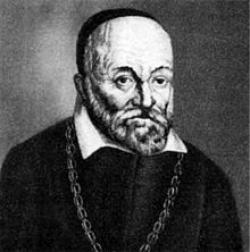Hieronymus Fabricius

Hieronymus Fabricius
- Born
- 20 May 1537
- Died
- 21 May 1619 (age 82)
Hieronymus Fabricius revolutionised the teaching of anatomy and helped to found modern embryology. He was tutor to William Harvey.
Fabricius studied at university in Padua in the 1550s and a few years later became its professor of surgery and anatomy. He carried out many dissections and investigated the formation of the foetus, and the structure of the stomach, oesophagus and intestines. He also studied the eye, ear and larynx and was the first person to describe the membranous folds in veins, which he called valves. William Harvey built on this work to establish the role of the valves in circulating blood through the body.
Father of modern embryology
Dr Singer, quoted in Hieronymus Fabricius Ab Aquapendente by S L Millard Rosernberg, April 1933
Among Fabricius’ dissections was that of the uterus and placenta of a pregnant woman. He produced two illustrated treatises on embryology, in 1600 publishing On the Formation of the Fetus, which contained the first detailed description of the placenta. It summarised his investigations into the foetal development of many animals, including humans, and opened the field for comparative embryology, helping to establish embryology as a separate science. Harvey used these writings as the basis for his own book on embryology.
Fabricius’ knowledge of anatomy helped him to introduce improvements in surgery and he also changed the way that it was taught. His talents were recognised by the Republic of Venice and in 1594 he designed the first theatre for public anatomical dissections, which the Republic built for him.
Fabricius’ writings described the technique of tracheostomy, although he never performed one himself, this procedure is similar to that used today. He gave the first full account of the larynx as a vocal organ and was the first to demonstrate that the pupil of the eye changes its size.
In 1600, he published Tabulae Pictae, which described the central fissure separating the temporal and frontal lobes in the brain.



